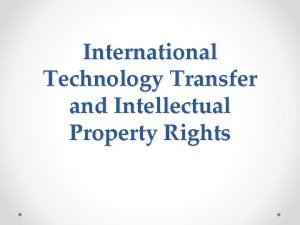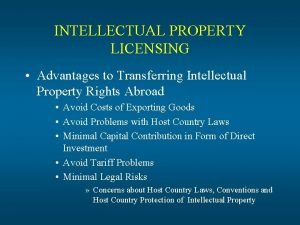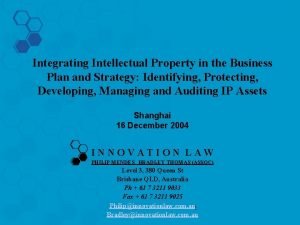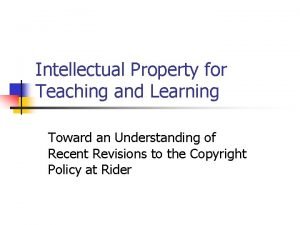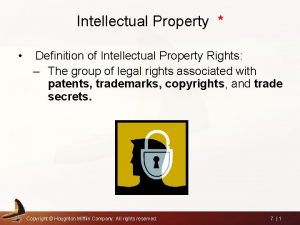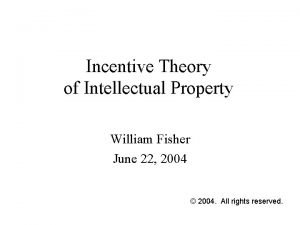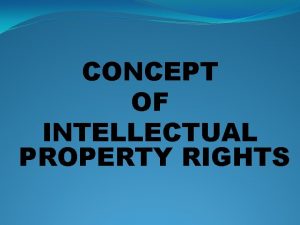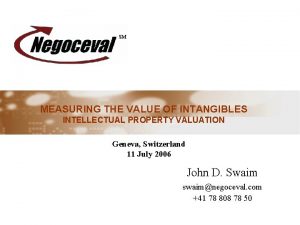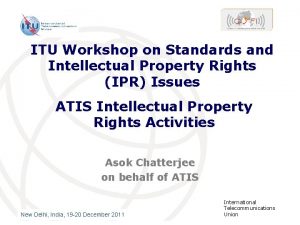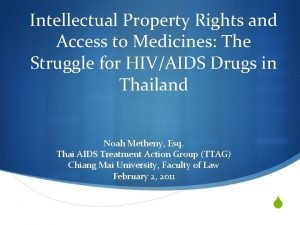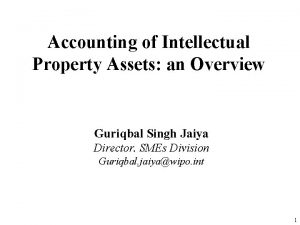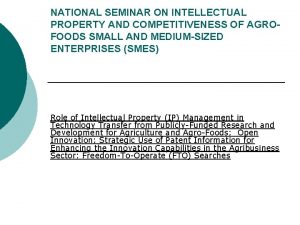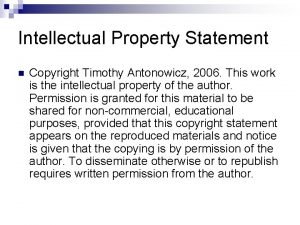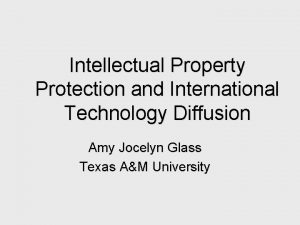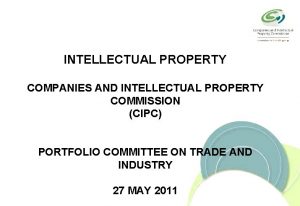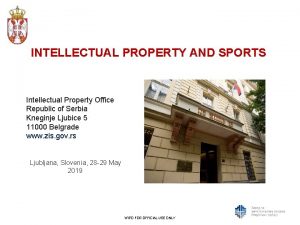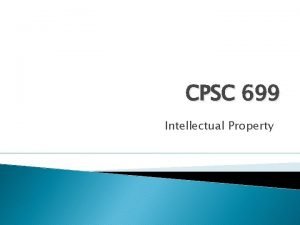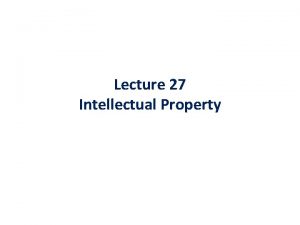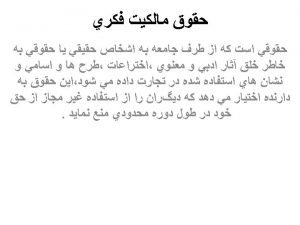Intellectual Property Protection and International Technology Diffusion Amy






















- Slides: 22

Intellectual Property Protection and International Technology Diffusion Amy Jocelyn Glass Texas A&M University

Spillovers: Effects and Issues • How do technology spillovers affect a foreign firm’s decision whether to produce in a host country? • How does foreign direct investment (FDI) affect the host country? • Can stronger intellectual property (IP) protection attract FDI? • Does the host country benefit? • Is IP protection a good way to attract FDI?

Empirical Evidence • Support for FDI generating technology spillovers: – Haddad and Harrison (1993), Kokko (1994). • Support for IP protection affecting FDI: – Lee and Mansfield (1996), Smith (2001), Javoncik (2001), Nunnenkamp and Spatz (2004).

Existing Models • Technology spillovers influence FDI decisions: – Siotis (1999), Petit and Sanna-Randaccio (2000). • Multinational firms control technology spillovers through labor mobility by paying high wages: – Markusen (2001), Fosfuri, Motta, and Ronde (2001), Glass and Saggi (2002).

Core Elements • Multinationals possess superior process technology. • Producing in host country lowers production costs. • Domestic firms learn about better techniques when multinationals enter (demonstration effect). • Laws protecting IP limit ability of domestic firms to benefit from spillovers.

Model of Technology Spillovers • • One source and one host firm (n host firms later). Source firm has superior process technology. Source firm chooses exports or FDI lowers cost of source firm: marginal cost 1 with FDI, W > 1 without. • FDI also lowers cost of host firm due to technology spillovers: marginal cost q with FDI, Q > q without.

Spillovers & Host Firm’s Costs • Host country’s IP protection sets fraction m of technology that may be legally imitated. • Technology spillovers generate knowledge flows to host firm, fraction sj. – Spillovers larger under FDI than exports s. X < s. F, s. X = s. F/Y, Y > 1 • Host firms able to absorb fraction a.

Host Firm’s Costs • Host firm’s technology (unit labor requirement) is weighted average of source firm’s superior technology of 1 and existing technology G > 1. • Weights are asjm and 1 - asjm. q = as. Fm + (1 - as. Fm) G, when FDI. Q = as. Xm + (1 - as. Xm) G, when exports.

Timing • • Host country sets its IP protection. Source firm chooses FDI or exports. Spillovers and absorption occurs. Host and source firm pick quantities (standard asymmetric Cournot duopoly/oligopoly). • Resulting prices, profits, consumer surplus, and welfare determined.

Source Profits • IP protection limits degree that host rival can use technology spillovers. • Stronger IP protection raises cost of host rival more under FDI than exports due to greater degree of technology spillovers. • Source profits increase with IP protection (decrease with imitation) more under FDI than exports.

Source: Exports or FDI?

Source Imitation Threshold • Source imitation threshold m. S is level of IP protection such that source profits under FDI equal source profits under exports. • It is minimum level of IP protection required for source firm to choose FDI. • When IP protection sufficiently strong, source firm chooses FDI (otherwise exports).

Proposition 1 • IP protection can be used to attract FDI. • FDI occurs when imitation sufficiently low m < m. S.

Proposition 2 • The source threshold decreases with – Larger technology gap G. – Larger technology spillovers under FDI relative to exports Y. – Larger absorption ability a. – Larger number of host firms n. – Smaller cost reduction W.

Host Profits • Recall that IP protection limits degree that host firm can use technology spillovers. • Stronger IP protection raises cost of host firm more under FDI than exports. • Host profits decrease with IP protection (increase with imitation) more under FDI than exports.

Host: Exports or FDI Better?

Host Imitation Threshold • Host imitation threshold m. H is level of IP protection such that host profits under FDI equal host profits under exports. • It is maximum level of IP protection such that host firm benefits from FDI by source firm. • When IP protection is sufficiently weak, host firm prefers FDI (otherwise exports).

Proposition 3 • The host country can benefit from using IP protection to attract FDI. • The host firm benefits from FDI by the source firm provided IP protection sufficiently weak m > m H.

Host versus Source Threshold • Host threshold lower than source threshold. • At source imitation threshold, FDI benefits host country: host profits and consumer surplus rise (lower price & higher quantity). • Possible for host country to benefit by strengthening IP protection to attract FDI. • Does host country always benefit? No.

Host Country IP Protection • Host profits may fall if start from weak IP protection. • FDI adversely selected in industries with least benefits for host. • With multiple industries, gain in one industry can be offset by losses in other industries due to higher costs for host firms.

Conclusions • Raising IP protection can attract FDI, provided FDI generates larger technology spillovers than exports. • Doing so need not benefit host country. – Handicaps local firms. – Adversely selects FDI with least benefits for host country. – Applied equally across industries.

Conclusions • IP protection not best policy instrument for attracting FDI. • Use targeted financial incentives. • Make country more attractive in other ways.
 Simple diffusion
Simple diffusion Relocation diffusion diagram
Relocation diffusion diagram Trade related aspects of intellectual property rights
Trade related aspects of intellectual property rights Secondary infringement
Secondary infringement Importance of intellectual property
Importance of intellectual property Intellectual property management definition
Intellectual property management definition Licensing advantages
Licensing advantages Intellectual property in business plan
Intellectual property in business plan Property
Property Right to intellectual property of teachers
Right to intellectual property of teachers Definition of ipr
Definition of ipr Incentive theory
Incentive theory Concept of intellectual property
Concept of intellectual property Intellectual property valuing
Intellectual property valuing Intellectual property rights
Intellectual property rights Intellectual property rights
Intellectual property rights Characteristics of intellectual property
Characteristics of intellectual property Discuss intellectual property frankly
Discuss intellectual property frankly Gaap accounting for intellectual property
Gaap accounting for intellectual property Intellectual property
Intellectual property Intellectual property statement
Intellectual property statement Intellectual property business plan example
Intellectual property business plan example Evalueserve intellectual property
Evalueserve intellectual property




